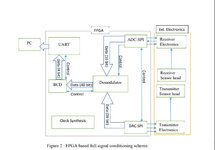Div_01
Newbie level 4
Hi,
I have a question regarding addition in digital electronics, quite application specific.
1)Let's say, I have 2 16-bit data coming from DAC and ADC to the demodulator that is 32 bits after multiplying. How many times is addition done to obtain a 40 bit data?
2) What would be the demodulator clock period for a 50MHz internal clock frequency and 32KHz sine wave? The answer that is obtained is 1320 as the demodulator clock period. But I am unable to understand how that number is obtained.
Please let me know if more details are required.
Can anyone explain me the procedure as well?
Thanks,
Divya
I have a question regarding addition in digital electronics, quite application specific.
1)Let's say, I have 2 16-bit data coming from DAC and ADC to the demodulator that is 32 bits after multiplying. How many times is addition done to obtain a 40 bit data?
2) What would be the demodulator clock period for a 50MHz internal clock frequency and 32KHz sine wave? The answer that is obtained is 1320 as the demodulator clock period. But I am unable to understand how that number is obtained.
Please let me know if more details are required.
Can anyone explain me the procedure as well?
Thanks,
Divya
Last edited:

